The submarine Jantina was an Argonaut-class coastal submarine (650 tons surface displacement and 800 tons submerged displacement). Together with its sister boat Jalea, it differed from the other units in the class by a different engine apparatus (FIAT diesel engines and CRDA electric motors, while Salpa and Serpente had Tosi diesel engines, Marelli electric motors, while Argonauta, Medusa and Fisalia had both diesel and CRDA electric engines).
The unit carried out 7 offensive/exploratory missions in the war and 4 for transfer or exercise, covering a total of 5,634 miles on the surface and 1,203 submerged, spending 72 days at sea.
Brief and Partial Chronology
January 20th, 1930
Set-up began at the Odero Terni Orlando’s Muggiano shipyards (La Spezia).
May 16th, 1932
Jantina was launched at the Odero Terni Orlando del Muggiano shipyard (La Spezia).
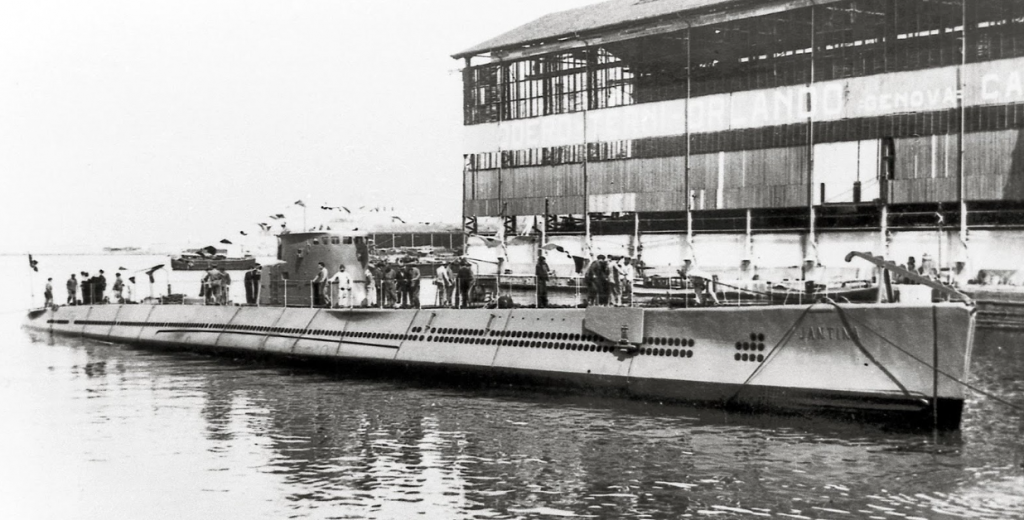
Jantina after it was launched
March 1st, 1933
Official entry into active service. Jantina was initially assigned to a “mixed” squadron (i.e., made up of submarines of different classes) based in La Spezia. In the same year, the painter Anselmo Bucci made a trip to Jantina. One of its first commanders was Lieutenant Giuseppe De Angioy.

Jantina while been fitted before deployment. The other submarine is the sister boat Jalea
End of 1935
Jantina and her sister ship Medusa were deployed in the Dodecanese, assigned to the Leros Submarine Group, remaining there for about a year.
December 10th, 1936
Lieutenant Cristiano Masi assumed command of Jantina.
January 24th, 1937
Jantina (Lieutenant Commander Cristiano Masi), part of the VI Submarine Group of Leros, set sail from La Spezia to carry out a clandestine mission in the waters off Barcelona as part of the Italian underwater operations during the Spanish Civil War. Italian submarines operated in support of Francisco Franco’s Spanish Nationalist forces, trying to hinder the flow of supplies for the Spanish Republican troops.
January 31st, 1937
After patrolling the Barcelona area for a week to no avail, Jantina returned to La Maddalena. On the return voyage, the submarine suffered a breakdown, and had to be towed to port by the light cruiser Eugenio di Savoia.
August 14th, 1937
Jantina (Lieutenant Gustavo Miniero), while assigned to the I Submarine Group of La Spezia, sailed again from La Spezia for another clandestine mission off the coast off Barcelona during the Spanish Civil War. In this period, the rules of engagement – which impose the utmost secrecy, since there is no formal state of war between Italy and Republican Spain, and therefore the activity of Italian submarines was illegal – prescribed to attack: the military vessels of Republican Spain, Republican or Soviet merchant shipping in both territorial and international waters, merchant vessels of any nationality which are caught sailing at night with their lights off within three miles of the Spanish coast controlled by the Republicans, or which are under escort by Republican ships, or which are at night sailing with their lights out under the escort of warships of any nationality.
August 17th, 1937
On the night of the 17th, off the coast of Barcelona, Jantina sighted a destroyer and fired two torpedoes without being able to hit the target. The destroyer retaliated with a heavy hunt with depth charges, but the submarine did not suffer any damage.
August 22nd, 1937
Jantina returned to La Maddalena, thus concluding its second and last “Spanish” mission.
June 19th, 1938
Jantina received the combat flag, donated by the city of Bergamo and delivered by Countess Laura Calvi Roncalli, provincial trustee of the women’s fascist organization. Both Jantina and the twin boat Jalea spent most of the period immediately preceding World War II in the Dodecanese.
May 10th, 1940
Jantina, together with the submarines Ametista, Jalea, Delfino, and Zaffiro, left Messina to move to the island of Leros, the main naval base of the Italian Dodecanese. The transfer of the five submarines was arranged to reinforce the submarine forces deployed in the Dodecanese (Tricheco, Squalo, and Narvalo submarines), in preparation for the now imminent war. A few days later, the five boats crossed the Aegean and reached their destination.
June 10th, 1940
Italy entered the Second World War. Jantina (Lieutenant Commander Vincenzo Politi) was part of the LII Submarine Squadron (V Grupsom), based in Leros, along with the similar boats Zaffiro, Ametista and Jalea. The day of the declaration of war, Jantina set sail for the first mission, a patrol in the Kasos Channel (between Crete and the island of Kasos) in an area adjacent to that assigned to Jalea.
June 20th, 1940
Jantina left the patrol area to return to base, without encountering any enemy ships.
June 21st, 1940
The boat returned to Leros.
July 2nd, 1940
Jantina set sail for a new mission, a patrol of the channel between Cerigo and Cerigotto.
July 8th, 1940
During the afternoon, Jantina detected the sounds of propellers of naval units passing through the area on the hydrophones but failed to spot enemy ships.
July 13th, 1940
The boat returned to base.
In this period, food rationing began in Leros: from the entry into the war until the fall of Greece and Crete (April-May 1941), in fact, the Dodecanese found itself substantially under naval blockade, supplied only by a few solitary ships sent every few months with the bare necessities to ward off the specter of hunger. In Leros, however, the situation was less problematic than elsewhere, because the Navy, unlike the Army and the civil administration, has long since created substantial reserves of food for its personnel. For the others, life in Leros passes monotonously: the war seems far away, the only ones who participated were the planes and submarines, such as Jantina, which “went to look for it” outside the waters of the Dodecanese.
August 17th, 1940
Jantina left Leros for another mission, a patrol of the waters between Cape Sidero and the Cyclades Islands.
August 31st, 1940
The boat returned to Leros, at the end of an unsuccessful mission.
September 5th through -October 10th, 1940
Round of routine maintenance work in the local shipyard. During this period, on September 20th, the first British air attack on Leros took place. All bombs fell in the countryside, without causing damage to military installations, despite claims to the contrary in British bulletins. The only victim of the raid was a Greek farmer, killed by a bomb along with some animals.
October 24th-25th 1940
Jantina was sent on patrol between the islands of Scio and Kaloyeri (Aegean Sea).
November 26th, 1940
Second British bombing of Leros: this time the bombers, Fairey Swordfish led by Lieutenant Richard W. V. Hamilton of the 819th Squadron of the Fleet Air Arm (who in peacetime had stayed in Leros as a tourist, which had allowed him to observe the military installations on the island), conducted an attack at low altitude under cover of darkness, They took the Italian defenses by surprise, and managed to inflict considerable damage on the ground installations, causing about forty victims and also hitting the barracks used by the submarine crews with two bombs. On the other hand, naval units, including submarines, did not suffer any damage.
A few days later, the British bombers returned, again led by Hamilton: this time, however, the defenses were on alert and set a trap for the attackers, letting them get close enough before opening fire. Hamilton’s plane was shot down by battery 306, crashing and causing the death of the pilot and the entire crew. Other planes were hit and were seen falling into the sea. On the Italian side, there were no losses.
The following day, the remains of Lieutenant Hamilton and his men were buried in the cemetery of Temenia with solemn honors. This failure would mark the end of British air attacks on Leros for a long time.
December 3rd, 1940
Jantina was sent on patrol off the Cyclades Islands.
December 4th, 1940
Following serious breakdowns which occurred on the first day in the area of operations, Jantina had to interrupt the mission and return early to Taranto for the works.
On the same day, the British code breakers of Bletchley Park (later to become known as “ULTRA”, a name not yet assumed at the time), probably on the basis of some ciphers captured in the previous months on board captured Italian submarines (Galileo Galilei) or boarded before the sinking (Durbo, Uebi Scebeli), managed to decipher some Italian communications that allowed them to communicate to the command in Alexandria in Egypt that Jantina was at that moment in an area of operations between 36°30′ N and 37°00′ N and between 26°30′ E. However, the information did not translate into an attack on the submarine (perhaps because it had to leave that sector the same day to return to base).
December 20th, 1940, through May 30th, 1941
Jantina was in the shipyard of Taranto undergoing extensive work.
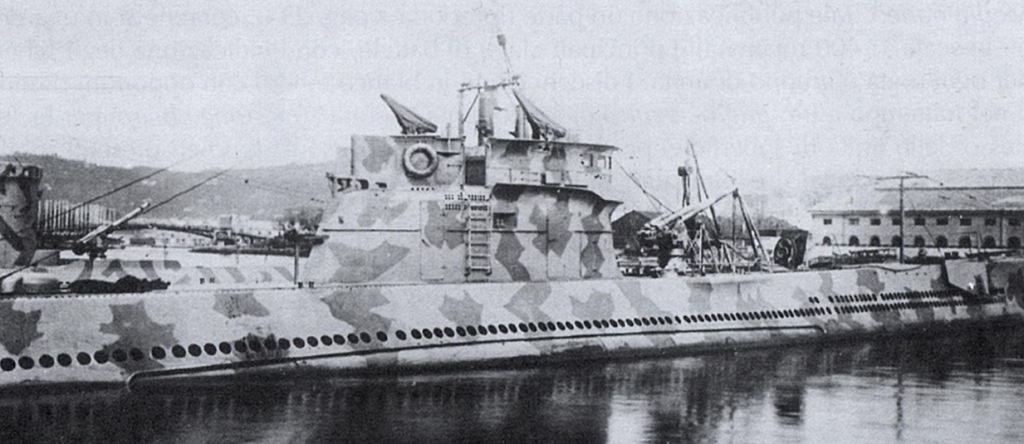
Jantina at the quay of the 1st Grupsom in La Spezia. At the end of the period of work carried out in the La Spezia’s shipyard: a splash guard was made under the windows of the bridge, and an experimental camouflage scheme was applied (in March 1941), with spots with straight edges in iron gray on a light ash background. Based on comparative tests with other submarines equipped with other camouflage schemes, a standard camouflage scheme would later be defined which was then be applied to all submarines in the Mediterranean
(From MILITARY HISTORY)
June 1941
Once the work was completed, Jantina was relocated to Augusta.
June 11th, 1941
The boat left Augusta for a patrol off the coast of Haifa.
June 15th, 1941
Afflicted by engine failures, Jantina had to divert to Leros.
June 21st, 1941
Once repairs were completed, Jantina (Lieutenant Commander Vincenzo Politi) left Leros for a mission in Egyptian waters.
June 27th, 1941
At 5:45 AM, immediately after arriving in the assigned area, Jantina sighted in position 31°34′ N and 27°28′ E (off Marsa Matruh) a unit identified as a “Hero-class” (i.e., H-class) destroyer, and launched a torpedo at close range. As it disengaged by diving (for a source, after the scheduled time for launch), Jantina distinctly hears a loud detonation.
The unit attacked was the Australian sloop H.M.A.S. Parramatta (Lieutenant Commander Jefferson Hirst Walker), sailing towards Marsa Matruh, which was not hit. The torpedo, set for an excessive depth – since H.M.A.S. Parramatta has a slightly lower draft than an H-class destroyer – passed under its hull without exploding. H.M.A.S. Parramatta counterattacked with depth charges, and later the destroyer H.M.A.S. Stuart (Captain Hector Macdonald Laws Waller), also Australian, joined the chase. (According to another source, probably erroneous, the target attacked and missed by Jantina was the British destroyer H.M.S. Hotspur, belonging to the H class).
Immediately after the attack, Jantina was subjected to heavy hunting with depth charges by ships and planes, which lasted for a total of forty-eight hours. Janita finally managed to escape the hunt, but seriously damaged, with numerous breakdowns, damaged machinery, dangerous water infiltration and severe air leaks, had to return to Leros.
For the action of June 27th, to which at the time the Italian side erroneously attributed the sinking of a destroyer (due to the explosion heard after the launch of the torpedoes), Commander Politi received a Silver Medal for Military Valor with this motivation: “Commander of a submarine, in a daring war mission, resolutely attacked the enemy by sinking a ct. enemy, demonstrating high aggressive spirit, serene daring and very high professional qualities. Signaled by a violent, prolonged hunt, he maneuvered with skill and courage, succeeding, despite the serious breakdowns suffered, in disengaging and bringing the unit under his command to base. In the fulfilment of his task, he made an ardent and passionate contribution to his soul, tempered by the hard school of duty and sacrifice, giving proof of superb military virtues”).
The rest of the crew was also be decorated for action; the second in command Loggini, the chief engineer Pirro, the navigation officer Colombo, the midshipman Giadrossi, the chief electrician Polito and the chief mechanic Da Rold received the Bronze Medal for Military Valor, the rest of the crew the War Cross for Military Valor. The decorations, however, were almost all awarded posthumously.
The Sinking
The serious damage suffered during the last mission off the coast of Egypt had reduced Jantina “to a state of inefficiency” and could not be repaired with the modest means available in the Dodecanese. Consequently, it was necessary to send it to Italy to carry out the necessary repairs, even if the transfer in those conditions (the damage suffered prevented it from diving), having to make a long journey in waters infested by enemy submarines: it was anything but simple.
It was decided that from Leros Jantina would first reach Corinth and then Messina, and then continue to Naples, its destination, where it would enter the dock for the works. According to other sources, however, Jantina was to have sailed from Leros to Brindisi, and repair work were to be carried out in this base.
In any case, in the early hours of July 5th, 1941, Jantina left Leros to return to Italy. It was commanded, as in all missions since the beginning of the war a year earlier, by the Lieutenant Commander Vincenzo Politi. Due to the damage suffered, the submarine had to complete the entire navigation while remaining on the surface, with all the risks that that entailed.
Unfortunately, Jantina didn’t have to go far before it ran into one of these dangers. At 5:46 PM on July 5th, the British submarine H.M.S. Torbay (Lieutenant Commander Anthony Cecil Capel Miers), being 11.5 miles by 240° from the Greek island of Stapodia, sighted another submarine sailing on the surface, four miles away, on 080° bearing; It was Jantina.
H.M.S. Torbay immediately approached in the direction of the newcomer, and at 6:16 PM, arriving in a position suitable for launch, launched six torpedoes from a distance of 1,370 meters. The sun was setting.

H.M.S. Tombay. The skipper, Lieutenant Commander Anthony Cecil Capel Miers, in July 1941, on his first patrol from Alexandria, was involved in two incidents of alleged war crimes. On two occasions after sinking enemy ships, Lt.Cdr. Miers had H.M.S. Torbay’s crew fire on troops as they swam in the water. Lt.Cdr. Miers made no attempt to hide his actions and reported it in his official logs.
On Jantina, which at that time was across the island of Mykonos (mentioned by Italian sources as Mykoni or Mykoni), no one suspected anything. At 6.15 PM, according to Italian sources – two torpedo trails were sighted, very close, and the crew realized that they were under attack. Unfortunately, it was already too late: the torpedoes, when they were sighted, were too close, and it was not possible to avoid them. Hit by two of the weapons, one at the bow and the other amidships, Jantina sank in less than a minute, in position 37°21′ N and 25°20′ E (according to Italian sources; in the Aegean Sea, three or four miles south of Mykonos) or 37°30′ N and 25°00′ E (according to British sources; east of Mykonos; another British source states “south of Melos” but this is certainly a mistake).
On H.M.S. Torbay, one minute after the launch, “an explosion was recorded, followed ten seconds later by a tremendous double explosion,” which shook the British boat violently, causing some minor damage. When Miers glanced at the periscope, he saw an approaching plane, so he decided to descend into the depths and move away (according to one source, the plane also dropped a depth charge at H.M.S. Torbay, but it did not suffer any major damage).
Most of the 47 (according to another source 48) men who made up the crew of Jantina were below deck at the time of the torpedoing. They had no escape and sank with the submarine. The men on the bridge were thrown overboard by the explosion, and found themselves in the water, confused and groggy. Only six survived, swimming to nearby Mykonos: Ensign Michele Giadrossi, and five non-commissioned officers and sailors.
Commander Politi, three other officers, and 37 non-commissioned officers, sub-chiefs and sailors perished with Jantina.
Note – An Internet source (ANMI – Italian Association Navy Veterans – Gaeta website) reports, in addition to the 41 names listed above, also those of six other fallen:
- Sailor Sebastiano Agliano
- Chief of First Class Arturo Brandani
- Sailor Tommaso Ferragina
- Sailor Alberto Morbin
- Sailor Giuseppe Poggi
- Sailor Giuseppe Tesoriero.
In the list of the fallen and missing of the Navy in the Second World War, however, the name of Sebastiano Agliano does not appear, while Brandani, Ferragina, Morbin, Poggi and Tesoriero all belong to the crew not of Jantina, but of the submarine Sirena: Brandani, Ferragina, Poggi and Tesoriero died on April 10th, 1943 in the bombing of the base of La Maddalena, while Morbin died in Italy at the end of the war, November 24th, 1946.
After a few days, only five bodies could be recovered: those of Commander Politi, the Assistant Chief Engine Engineer Sante Bobbo, the Second Chief Torpedo Pilot Valdemaro Castagneto, the Chief Mechanic Amleto Cerutti, and Sailor Electrician Middel Costa. They were buried in the cemetery of Leros.
On July 10th, 1941, Captain Aldo Cocchia, military commander of Leros, wrote in his diary:
“… Today we feel a very different emotion at the sad ceremony of the funeral of the Lieutenant Commander Politi, commander of the submarine Jantina. Jantina had departed from Leros two days ago bound for Italy and, when we greeted with affectionate cordiality this submarine that was returning after a period of good work in the Aegean, we would never have thought that its hours were numbered. Off the coast of Miconi, Jantina was torpedoed by an enemy submarine and sank rapidly, taking almost all of its crew with it. Rescue vessels departed from Leros and Dira, but unfortunately, they managed to save only two young officers and recover the bodies of the commander and four men. Admiral Biancheri spoke at the funeral and spoke a few words, but there were no words that could express our emotion.”
Later, in his memoir “Convoys”, Cocchia describes the small cemetery of Leros in which the remains of Commander Politi and the four men recovered from the sea rested for some time, until the post-war period:
“No, there is nothing very suggestive or poetic about our cemetery, located, as it is, on the barren hill, enclosed by a white wall. A few stunted and withered cypresses, almost all planted this year [1941], fail to create that atmosphere of sweet recollection typical of country graveyards. The altar against the back wall is too open, too exposed to invite prayer. The tombs are lined up in several rows, as if the soldiers and sailors sleeping there were still in line. And perhaps their spirits are now in line, framed as a time to watch over us as we continue their work. Tombs all the same, without monuments and without epigraphs, all covered with a concrete slab surmounted by a cross, all bordered by a band of flowers – anemones, dahlias, chrysanthemums – all with a bronze plate on which are imprinted a name, two dates. Nothing else. Under the grey concrete slabs lie sailors and soldiers who have fallen while serving, in aerial bombardment, in war, for whatever reason. The last arrivals were the five of the submarine Jantina. In a corner of the cemetery rest English airmen shot down by our artillery, and among them is Captain Hamilton who for many years had come, in peace, on vacation in Leros.”
Commander Politi and Sub-Chief Bobbo rest today at the Memorial of the Fallen Overseas in Bari. Almost all the other men of Jantina, to use the words of Aldo Cocchia referring to the many sailors and airmen who left Leros and never returned, “now sleep under the great blue shroud of the sea”.
After eight decades of oblivion, the wreck of Jantina was spotted in November 2021 by a group of Greek divers from Kostas Thoctarides, during the inspection of a submarine fiber-optic cable. The unfortunate submarine now lies at a depth of 103 meters, lying on its left side. It is well preserved and generally intact, except for the extreme bow, removed by the explosion of one of the torpedoes. The hatch of the conning tower is open, and the periscopes are lowered, since the vessel was on the surface when it was sunk.
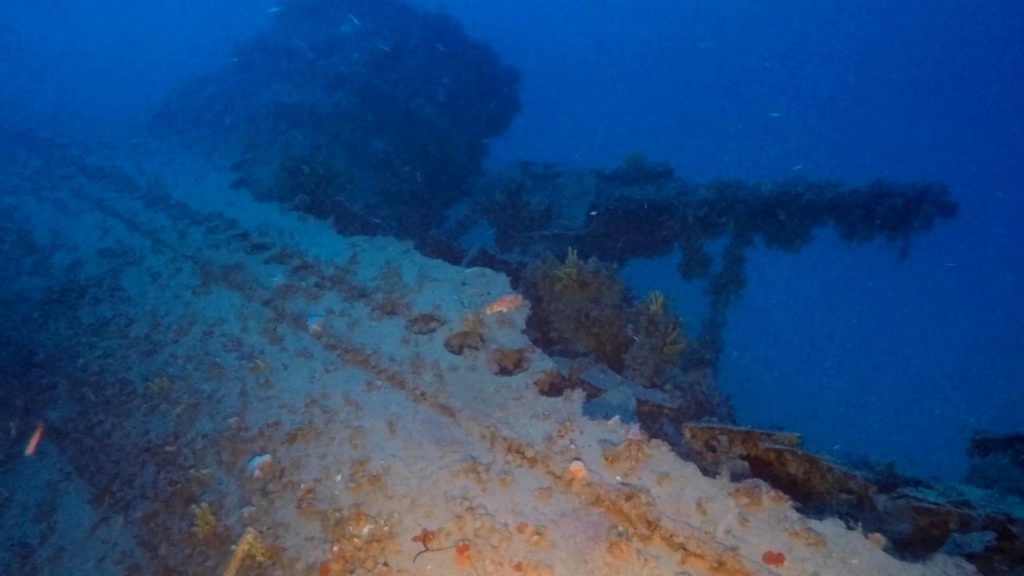
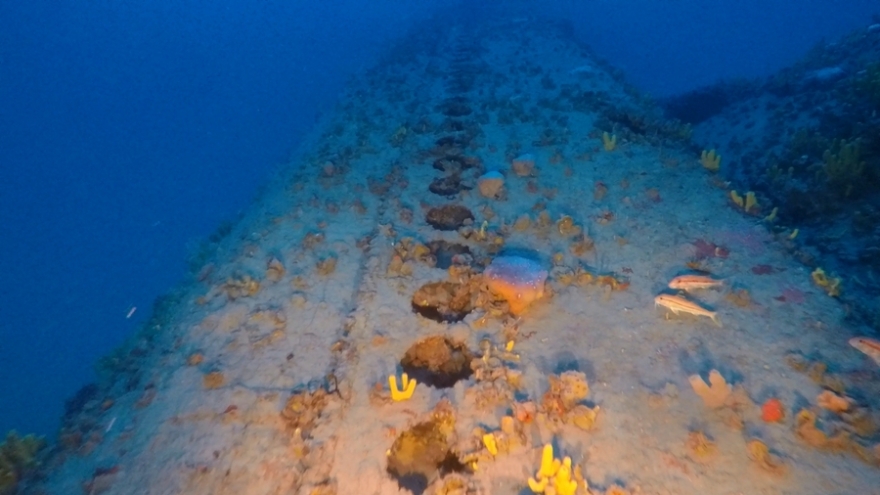
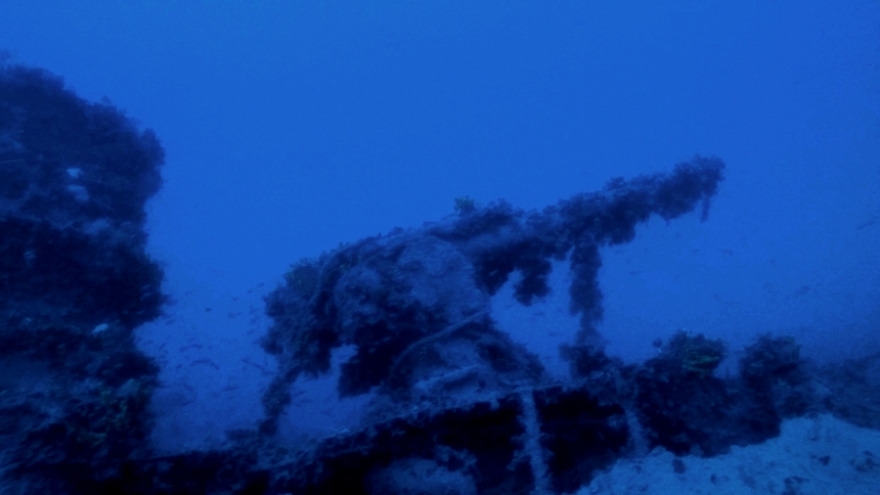
Images of the relict of Jantina, a war grave, by Kostas Thoctarides
The sinking of Jantina in the Torbay logbook (from Uboat.net):
“At 19:46 hours, while Torbay was in position 240° Stapodia Island 11.5 nautical miles, a submarine was sighted bearing 080° 4 nautical miles away. Torbay at once turned to engage the target.
At 20:16 hours 6 torpedoes were fired from 1,500 yards. One minute later an explosion was heard followed by a tremendous double explosion 10 seconds later. The explosion shook Torbay violently causing some light damage. When Lt.Cdr. Miers took a look through the periscope an aircraft was seen approaching so he took Torbay deep.”
Original Italian text by Lorenzo Colombo adapted and translated by Cristiano D’Adamo
Operational Records
| Type | Patrols (Med.) | Patrols (Other) | NM Surface | NM Sub. | Days at Sea | NM/Day | Average Speed |
|---|---|---|---|---|---|---|---|
| Submarine – Coastal | 11 | 5634 | 1203 | 72 | 94.96 | 3.96 |
Actions
| Date | Time | Captain | Area | Coordinates | Convoy | Weapon | Result | Ship | Type | Tonns | Flag |
|---|---|---|---|---|---|---|---|---|---|---|---|
| 06/21/1941 | 05:45 | C.C. Vincenzo Politi | Mediterranean | 31°34’N-27°28’E | Torpedo | Failed | H.M.A.S. Parramatta | Sloop | 1060 | Australia |
Crew Members Lost
| Last Name | First Name | Rank | Italian Rank | Date |
|---|---|---|---|---|
| Agliano | Sebastiano | Naval Rating | Comune | 7/5/1941 |
| Bobbo | Sante | Junior Chief | Sottocapo | 7/5/1941 |
| Bornacin | Domenico | Junior Chief | Sottocapo | 7/5/1941 |
| Bossi | Guerrino | Junior Chief | Sottocapo | 7/5/1941 |
| Brandami | Arturo | Chief 1st Class | Capo di 1a Classe | 7/5/1941 |
| Brescia | Vito | Naval Rating | Comune | 7/5/1941 |
| Casadio | Aurelio | Junior Chief | Sottocapo | 7/5/1941 |
| Castagneto | Valdemaro | Chief 2nd Class | Capo di 2a Classe | 7/5/1941 |
| Cella | Luciano | Junior Chief | Sottocapo | 7/5/1941 |
| Cerotti | Amieto | Chief 3rd Class | Capo di 3a Classe | 7/5/1941 |
| Colombo | Augusto | Ensign | Guardiamarina | 7/5/1941 |
| Conte | Antonio | Naval Rating | Comune | 7/5/1941 |
| Corrado | RÈ | Naval Rating | Comune | 7/5/1941 |
| Costa | Middel | Naval Rating | Comune | 7/5/1941 |
| D’arco | Salvatore | Naval Rating | Comune | 7/5/1941 |
| Darold | Bruno | Chief 2nd Class | Capo di 2a Classe | 7/5/1941 |
| Esposito | Rosario | Naval Rating | Comune | 7/5/1941 |
| Fardelli | Giuseppe | Naval Rating | Comune | 7/5/1941 |
| Feola | Attilio | Naval Rating | Comune | 7/5/1941 |
| Ferragina | Tommaso | Naval Rating | Comune | 7/5/1941 |
| Ferrigno | Antonio | Sergeant | Sergente | 7/5/1941 |
| Furettini | Martino | Chief 2nd Class | Capo di 2a Classe | 7/5/1941 |
| Gulinelli | Francesco | Naval Rating | Comune | 7/5/1941 |
| Laraspata | Vito | Junior Chief | Sottocapo | 7/5/1941 |
| Loggini | Vittorio | Lieutenant | Tenente di Vascello | 7/5/1941 |
| Maritano | Ermanno | Junior Chief | Sottocapo | 7/5/1941 |
| Mologni | Pietro | Naval Rating | Comune | 7/5/1941 |
| Montagna | Giacomo | Chief 2nd Class | Capo di 2a Classe | 7/5/1941 |
| Monticelli | Saverio | Junior Chief | Sottocapo | 7/5/1941 |
| Morbin | Alberto | Naval Rating | Comune | 7/5/1941 |
| Muollo | Alfonso | Naval Rating | Comune | 7/5/1941 |
| Pascale | Gerardo | Chief 2nd Class | Capo di 2a Classe | 7/5/1941 |
| Pirro | Guido | Sublieutenant G.N. | Tenente G.N. | 7/5/1941 |
| Poggi | Giuseppe | Naval Rating | Comune | 7/5/1941 |
| Politi | Vincenzo | Lieutenant Commander | Capitano di Corvetta | 7/5/1941 |
| Polito | Giovanni | Chief 1st Class | Capo di 1a Classe | 7/5/1941 |
| Rossi | Matteo | Sergeant | Sergente | 7/5/1941 |
| Selvaggio | Vinicio | Junior Chief | Sottocapo | 7/5/1941 |
| Sgroi | Vincenzo | Sergeant | Sergente | 7/5/1941 |
| Sorrentino | Giuseppe | Naval Rating | Comune | 7/5/1941 |
| Tesoriero | Giuseppe | Naval Rating | Comune | 7/5/1941 |
| Trombetti | Ruggiero | Junior Chief | Sottocapo | 7/5/1941 |
| Vecchietti | Armando | Sergeant | Sergente | 7/5/1941 |
| Zaccaro | Beniamino | Sergeant | Sergente | 7/5/1941 |
| Zagnoli | Arturo | Junior Chief | Sottocapo | 7/5/1941 |
| Zenier | Gino | Naval Rating | Comune | 7/5/1941 |
| Zoli | Michele | Junior Chief | Sottocapo | 7/5/1941 |